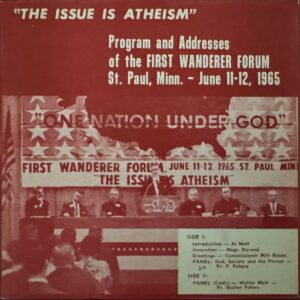Do We Really Need Our Mother of Perpetual Help in These Enlightened Times?

When I was little, about 3 perhaps, every Tuesday my mother and I would take the bus to the stately stone Church of the Assumption in downtown St. Paul for the weekly novena in honor of Our Lady of Perpetual Help. There were hymns and novena prayers in a little blue book with a picture of Mary on the cover. I sat on the large, shiny, dark pew for the homily and I remember not being able to understand a word the old pastor said. Years later I met that priest, who actually spoke quite clearly and wasn’t old at all, so the sound system must have been ancient. My favorite part was the Tantum Ergo during Benediction, when the old church shook as the organist played those low chords on the pipe organ in the W.A. Smit version of the hymn.

Perpetual Help – that’s an interesting concept. Do we actually need perpetual help in these enlightened days almost 70 years later?
My novena book, certainly passed on to me by my mother – she would be appalled by its present condition – dates from 1936. It has been updated, I am sure, but this aged booklet brings to mind a time when people believed in the spiritual life, that Satan existed and our souls were endangered by the snares of the devil. These novena prayers are begging for Our Lady’s intercession, particularly to help us poor sinners to have recourse to her in times of temptation:
For, if Thou protect me, dear Mother, I fear nothing; not from my sins, because Thou wilt obtain for me the pardon of them; nor from the devils, because Thou art more powerful than all hell together; nor even from Jesus my Judge, because by one prayer from Thee, He will be appeased. But one thing I fear, that in the hour of temptation, I may through negligence fail to have recourse to Thee and thus perish miserably. Obtain for me, therefore, the pardon of my sins, love for Jesus, final perseverance, and the grace to have recourse to Thee, O Mother of Perpetual Help.
Novena and Prayers To Our Mother of Perpetual Help, by the Redemptorists, Chicago, 1936.

Whence came this powerful devotion to our Blessed Lady and its beautiful icon?
The booklet itself comments:
During the last quarter of a century [imprimatur 1934], perhaps the most popular Novena among all classes of the faithful throughout the entire Christian world, is in honor of our dear and Immaculate Mother under the sweet and consoling title of “Our Lady of Perpetual Help,” and Mary, on her part, has ever shown herself to justify that beautiful title, as thousands in all parts of the globe can testify, who have received extraordinary favors, both spiritual and temporal, when invoking her intercession.
It seems as if Almighty God, ever guiding the Church, and her faithful children, with His Holy Spirit, reserved this beautiful devotion for the close of the nineteenth century to reawaken in an extraordinary manner, devotion to His ever Blessed Mother, under that sweet and loving title. He did this also to manifest how pleasing it is to His tender and loving heart, to bestow, on the devout clients of our Blessed Lady, His choicest graces and favors, when invoked under that sweet and endearing name of ‘Perpetual Help.’
Novena and Prayers To Our Mother of Perpetual Help, by the Redemptorists, Chicago, 1936.
Our Lady, the Missionary
According to the Redemptorists, the icon was entrusted to their order of missionaries and preachers in 1866 by Pope Pius IX with the commission to “make her known throughout the world.” Copies of the image went with missionaries around the world. One of the first copies came to the Basilica and Shrine of Our Lady of Perpetual Help in Boston in 1878, although St. Mary’s in Annapolis is reported to have been given a copy in 1868. Devotion to Our Lady under this title spread rapidly as did stories of favors received through her intercession. In Haiti, Our Lady is said to have alleviated a cholera and smallpox epidemic in 1882; in Spain, a miraculous cure occurred in 1918; in 2010, Pope Benedict invoked Our Mother of Perpetual Help for earthquake relief in Haiti. Novenas to Our Lady under this title date from around 1900. They began here in the US in St. Louis, Missouri between 1927 and 1935, using a book published by the Irish Redemptorists, of which mine is surely a survivor, at that time in the 88th printing.
One of Five Icons Painted by St. Luke
This icon of Our Lady is considered a true copy of a painting done by St. Luke upon a table at the home of the Holy Family in Nazareth. It is believed to have been written (icons are written. See the explanation of the Divine Mercy icon on our BF website) at the Keras Kardiotissas Monastery in Crete, and then stolen by a Roman merchant and kept by his family. In March of 1499, the Virgin appeared in a dream to the young daughter of the merchant. She told the little girl to tell her mother and grandmother to have the icon placed “between my beloved Church of St. Mary Major and that of my beloved son, St. John of Lateran,” which at the time was the Church of St. Matthew the Apostle in Rome.
The family immediately did as instructed and the icon stayed at the Church of San Matteo for 300 years, until it was moved to the Church of St. Mary in Posterula while Rome was engulfed in war as part of the French Revolution in 1798. The Church of San Matteo, as well as several others, were destroyed during the conflict.
The Redemptorists Become Her Home
Years later, in 1855, the Society of the Most Holy Redeemer, known as Redemptorists, established their headquarters in Rome, building a church in honor of their founder, St. Alphonsus Liguori, on the very site of San Matteo. When the Redemptorists found out the history of the icon, they asked that it be given to them. Thus in 1865, by Papal Edict, Pope Pius IX, gave the icon to the Redemptorists ordering its public veneration under the title Mater de Perpetuo Succursu. The icon still resides in the Church of St. Alphonsus in Rome.

As with all icons, there are many symbols in the artistic work. The background of gold symbolizes the Kingdom of God. Our Lady’s dress is red, the color of an Empress in Byzantine art. (Interestingly, Our Lady of Guadalupe who appeared in 1531, is frequently depicted with a red garment as well.) As the focus of the icon, Our Lady is larger than Jesus. She is depicted looking at the faithful, but with her hand pointing towards Jesus as the source of salvation. The icon shows Jesus looking back, toward the images of the Passion behind Him, which frighten Him. Michael on the left carries the lance and sponge and on the right, Gabriel carries a three-bar cross and nails. The Greek inscriptions read MP-ΘΥ (Μήτηρ Θεοῦ, Mother of God), ΟΑΜ (Ὁ Ἀρχάγγελος Μιχαήλ, Michael the Archangel), ΟΑΓ (Ὁ Ἀρχάγγελος Γαβριήλ, Gabriel the Archangel) and IC-XC (Ἰησοῦς Χριστός, Jesus Christ), respectively.
How this Little Hymn Book Came to be
The Redemptorists took their mission seriously in spreading devotion to Mary. Their founder, Alphonsus Maria de Liguori was a brilliant student, awarded doctorates of civil and canon law by age 16. By age 20 he was already thought of as a brilliant lawyer. At the same time, he was drawn to works of mercy and caring for the sick and poor as part of the Confraternity of Our Lady of Mercy which he had joined earlier. His yearning for acts of Christian charity and the love of God could not be denied and he was ordained in 1726. He was a popular preacher, easy to understand and inspiring, but wherever he went, his first concern was for the poor.
Others joined him in his “mission to the people” and they became known as the Congregation of the Most Holy Redeemer. They travelled in small groups to preach and minister to the people, always speaking of the redeeming love of God, the need for prayer, and the assistance of the Blessed Virgin Mary.
Alphonsus wrote many books, including Moral Theology, Visits to the Blessed Sacrament, The Glories of Mary, Prayer, The Great Means of Salvation. He authored the Spiritual Communion we have all prayed during this pandemic while denied church attendance. (see also, Lest Perhaps we die… with sermons by Alphonsus). One of his prayers is in the novena book to Our Mother of Perpetual Help. He wrote,
“I say, and repeat, and will keep on saying as long as I live, that our whole salvation depends on prayer…For if you pray, your salvation will be secure.”
So it is no surprise to find a century of prayers to Mary in a little blue book in the far corners of the world, and icons of Our Mother of Perpetual Help enthroned in churches and homes. I grew up with Our Lady under this title. Her presence was as normal as breakfast on the table each morning. Sometimes, though, a person becomes complacent with normalcy, even forgetful. So while this image is in our main living area, I had never really gone into depth about it. I said the prayers now and then, of course, but they didn’t really draw much meditation – until now, when Covid has given all of us the best gift in the world – isolation and resulting free time to pray.
The Feast Day of Our Mother of Perpetual Help is June 27.
Ave Maria!
A Few Notes…
Alone with God, published by the Redemptorists, Brooklyn, NY, 1975.
Novena and Prayers To Our Mother of Perpetual Help, by the Redemptorists, Chicago, 1936.
https://en.wikipedia.org/wiki/Our_Lady_of_Perpetual_Help
This article, Do We Really Need Our Mother of Perpetual Help in These Enlightened Times? is a post from The Bellarmine Forum.
https://bellarmineforum.org/do-we-really-need-our-mother-of-perpetual-help-in-these-enlightened-times/
Do not repost the entire article without written permission. Reasonable excerpts may be reposted so long as it is linked to this page.

